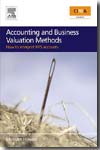Accounting and business valuation methods
how to interpret IFRS accounts
- ISBN: 9780750684682
- Editorial: Elsevier Science
- Fecha de la edición: 2007
- Lugar de la edición: Amsterdam. Países Bajos
- Encuadernación: Rústica
- Medidas: 24 cm
- Nº Pág.: 287
- Idiomas: Inglés

This book is intended to appeal to junior accountants who need guidance and practical analytical tools for risk assessment when assessing the credit risk of companies they are doing business with. It will also appeal to students taking modules that cover basic accounting techniques such as ratio analysis and investment appraisal, as well as company valuation and share valuation. The book demonstrates with case studies where practice often differs from theory.Chapter 1, looks at how accurate company accounts are, and covers topics such as the basic principles of accounting; accounting standards; the annual report; key words and limitations; what makes a director act imprudently; clues to assess accuracy. Chapter 2, considers the basic tools of analysis; reviewing market valuations and market to book ratio; assessing the balance sheet; is the company making good use of its assets; ratio analysis (performance, asset management, structure and investor ratios); investment appraisal procedures.Chapter 3 then looks at valuing companies: systematic and unsystematic risk; the Capital Asset Pricing Model (CAPM); income v growth; valuation techniques for manufacturing and service companies.Chapter 4 brings everything together via case studies: understanding the industry; benefiting from a cautious board; the cost of an imprudent board; price paid for excessive growth strategies; biting off more than one can chew; dramatic effect of stalled growth; overstated assets; profits without cash; and why it is usually better to be acquired. Via a through analysis of published company accounts. This book will show you, as a junior accountant and/or student of accounting how to: distinguish between mandatory and optional reports; assess the strength of a companys balance sheet; assess whether or not the market value of a particular company is justified; assess the risk factors associated with investment; examines the difference between mandatory and optional reports; explains how to asse






